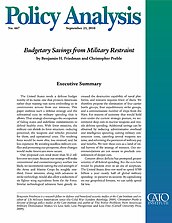Our proposed cuts total more than $1.2 trillion over ten years. Because our strategy will make conventional and counterinsurgency warfare less likely, we recommend cutting the end-strength of the Army and Marine Corps by roughly one third. Fewer missions, along with advances in strike technology, would also allow a reduction of six fighter wing equivalents from the Air Force. Similar technological advances have greatly increased the destructive capability of naval platforms, and restraint requires fewer of them. We therefore propose the elimination of four carrier battle groups, four expeditionary strike groups, and a commensurate number of ships from the Navy. For reasons of economy that would hold even under the current strategic posture, we recommend deep cuts in nuclear weapons and missile defense spending. Additional savings can be obtained by reducing administrative overhead and intelligence spending, cutting military construction costs, canceling several weapons systems, and reforming the provision of military pay and benefits. We view these cuts as a kind of initial harvest of the strategy of restraint. Our recommendations are not meant to preclude consideration of deeper cuts.
Concern about deficits has prompted greater scrutiny of all federal spending. But the cuts here would be prudent even in an era of surpluses. The United States does not need to spend $700 billion a year — nearly half of global military spending — to preserve its security. By capitalizing on our geopolitical fortune, we can safely spend far less.



